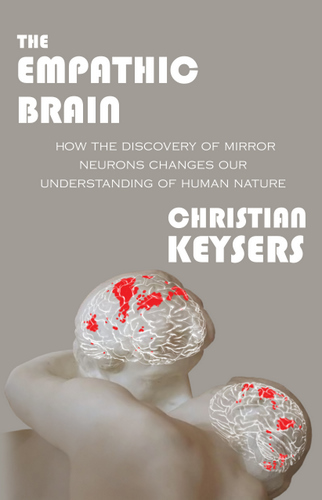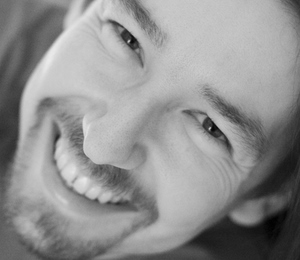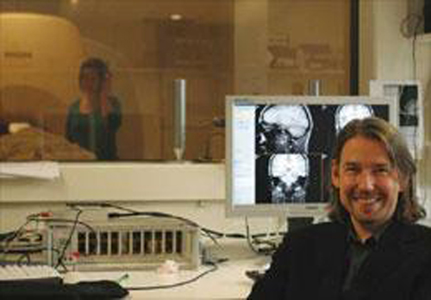- Hear About Mirror Neurons From One Of The Original Researchers
- How Do We Learn Facial Expressions?
- Is There A Connection Between Autism And Mirror Neurons?
Full Interview Audio

Personal Info
Favourite Books:
- Nausea by Jean-Paul Sartre
- Thus Spake Zarathustra by Friedrich Nietzsche
- The Myth of Sisyphus by Albert Camus
Most Influenced By:David Perrett, Vittorio Gallese, Valeria Gazzola (Wife), Gerard Keysers (Father), Bas Kast (Friend)
Company Website: http://www.nin.knaw.nl/research_groups/keysers_group
Interview Highlights
This is a condensed, lightly edited transcript of an audio interview. The full audio is available and highly recommended. The interviewee may post clarifications in the comments.
Adrian Bye: Today I’m here with Christian Keysers, who is a neuroscientist from the Netherlands Institute for Neuroscience. Christian, thanks for joining us. Can you tell us what it is you do?
Christian Keysers: The big question that fascinates me is how people can understand other people. How do we go from seeing facial expressions of people to really feel what goes on inside of them?
Adrian Bye: Would you focus that primarily around mirror neurons?
Christian Keysers: I got interested in the topic through mirror neurons. I used to work in visual neuroscience, where the big question is how the brain puts the information that enters your eyes together to make you see the world. But then you very quickly get to the point where I see somebody smile, I can understand how the brain makes me see this smile, but how do I know that that person is happy? To try to find an answer to that, I moved to Italy, where the team in Parma had just discovered mirror neurons.
I joined the team two years after they made the first publications and observations. The team was studying the motor part of the brain, to understand how a monkey or a human can actually control his own action. The way you do that is that you put little electrodes in the brain of a monkey. The monkey is not aware that there is an electrode, and you can listen into what single neurons do while you actually interact with the monkey.
They quickly realized that the neurons were involved in relatively high-level aspects of actions, like wanting to take an object. Then, only by accident, they noticed that each time they took an object to present to the monkey, the neuron was firing as if the monkey had done the action. In the beginning, they didn’t even believe that it was real, that the part of the brain that was supposed to take care of your own actions would actually be involved in perceiving the actions of others.
Adrian Bye: What does a mirror neuron look like? Is this something you can actually see?
Christian Keysers: The methods we use don’t actually look with a microscope in the brain. What we do is we have these little electrodes, like antennas, that basically capture the firing.
They are just like any other neuron that is involved in programming your own actions. What makes them special is that they seem to receive the right input from the visual part of your brain to also respond when you see a similar action done by somebody else.
Adrian Bye: When you are testing for them, are you able to isolate down to a single mirror neuron or are you at a group?
Christian Keysers: What you do is you use electrodes that just take in signals that are incredibly close to the tip of the electrode, so when you hear something, you are sure it’s a single neuron. That is why we are so sure that it’s the same neuron firing when the monkey does something and when the monkey sees somebody else do something.
Adrian Bye: What happens to the monkey at the end of this?
Christian Keysers: We interact with these monkeys for years. We work, sometimes, six hours a day with them. They are really like pets. The implants are small, and the brain is not pain sensitive.
When you need to record from a monkey, you basically just listen in. Each time you hear a neuron, you stop and you try to find out what the neuron does. The monkey is not aware of that, so you just interact with the monkey. You give him a peanut or an apple or you try to get him to do things with his hand or his mouth, always listening to what the neuron does. Until you find the action that when the monkey does it, it always activates that neuron.
Then you know this is a neuron that is involved in breaking a peanut. While you are still listening to the neuron, you then take a peanut and break it yourself and you see whether that excites the neuron. If it does, you know it’s a mirror neuron. Then you can go stand behind the monkey and break a peanut to check whether the sound of breaking a peanut also does the job. And it turns out that it does.
Adrian Bye: When you move behind him and check the sound, was that the same mirror neuron that fired by sight?
Christian Keysers: Yes. That was one work I did in Parma, to establish the fact that mirror neurons do not only respond to the sight of other people’s actions, but also to the sound.
You may remember the famous radio advert that Coca-Cola had for a while. They just open the Coca-Cola bottle, pour the drink, and then go “Ah”. It really made you long for something to drink yourself. The kind of mirror neurons that we found also respond to the sound of an action, like biting or drinking, and the fact that you share the actions that you hear can explain why these radio adverts can be so powerfully engaging.
The idea is that when you, for the first time, open a Coca-Cola can and hear this hissing sound, then the neurons in your brain that make you open the can will be active at the same time as the neurons that make you hear the hissing. Because they are going to be active together, every time you open the coca-cola can, you’ll get this strong association within the brain getting thicker connections between the motor neuron and the auditory neuron.
If you have done that a couple of times, and you then hear somebody else open the Coca-Cola can, you activate one of the two neurons and through the thicker connections, it will then activate the motor program that you used to cause the same sound. Therefore, it is this pairing or anchoring, between doing an action and seeing and hearing it, that will wire up your brain with mirror neurons that can activate the motor program if you see or hear the actions of others.
Adrian Bye: How do we learn facial expressions?
Christian Keysers: What happens in the brain is that when you see me smile, first you will activate part of your brain that you normally use to move your face in a similar way, the premotor cortex, and then that activates a part of the brain that is involved in feeling your own state. Through this double step of sharing the facial expression and then sharing the feeling behind it, you manage to really get what happens in the other person’s mind.
Parents have the tendency to imitate the facial expressions of their kids. If the kid is happy, and then looks up to his mother, he’s going to see his mother smile back at him. That gives him an opportunity to anchor, or associate in Hebbian learning, his happiness with the look of a smile. If he falls down and starts crying, the mother’s facial expression will look sad, and that will give him an opportunity to pair his own pain and distress with what the distressed facial expression looks like.
Our parents mirror our own facial expressions and that gives us the opportunity to associate this complex expression, which is a movement of the face a certain way or the tone of voice, with an inner state that we experience at that moment. Once this association has been built up, the next time you see the facial expression, you’ll have this recall of the rich emotional feelings that you had in the past.
Adrian Bye: Some of the recent research says that mirror neurons are not related to autism. What are your thoughts?
Christian Keysers: We were very interested in that as well. Part of our interest was triggered by the study that Mirella Dapretto had done. She found that if you look at the premotor cortex of children with autism and show them the facial expressions of others, you don’t see as much mirroring as you do in typically developing children. Then what we did was scan people ranging in age from young adults around 18 all the way up to people aged 50. We showed them the facial expressions of others and what we saw was, on average, they were doing just as much mirroring as typically developing individuals. But then when we looked at the different ages, what we saw was that the young adults were still mirroring less than their age matched controls, whereas the older patients with autism were actually doing more mirroring than the typically developing individuals.
The impression I got out of that is what may actually happen in individuals in autism is that because they’re not so interested as children in the faces of other people, they just don’t spend as much time staring at their mother’s face, for instance, and therefore, it takes longer for them to build up this association between their own inner feelings and what they look like on other people’s facial expressions.
Adrian Bye: You’re saying the motivation is missing?
Christian Keysers: Exactly. Because the motivation to seek these biological responses of others isn’t as strong, it just takes you longer to get the repetitions that would build up a mirror neuron. If it takes a hundred times to build up this connection and you’re really fascinated by faces, then in just a couple of months, it might be enough. If you’re more interested in other things, it may take you years to accumulate the same number of paired experiences. It will just take longer for this system to become fully wired up.
Adrian Bye: That disagrees with most of the current autism research.
Christian Keysers: I think one of the other related issues is the fact that there might be subtle differences in the synapses as well. The synapses are the part of the connection between neurons that can become stronger with experience, and it turns out that in some of the cases where we know what gene is different in subjects with autism, these genes often seem to code the plasticity of these synapses. That may also slow down how quickly you can wire up these mirror neurons, because those connections may be a bit more conservative and want a couple more experiences to wire up.
Adrian Bye: What about sociopaths and psychopaths?
Christian Keysers: What we found in autism is the system is actually relatively normal in the adult, it just develops in a different trajectory. When we looked at psychopaths, what we found was a bit different. If you take a psychopath and you put him in a scanner, and you make him feel a bit of pain, you will see the pain areas light up. Then you can show him a movie of somebody else experience pain and you will see that those pain areas do not light up. That would suggest they have a broken mirror system. But then we asked them to try to feel what the other person is feeling, and what we saw is that a psychopathic brain actually activates these pain areas in ways that look completely normal. It seems that the problem is not that they don’t have a functioning kind of empathy or mirror system, their thing is that they seem to have a gift to turn it on and off whenever they want to.
I think that is what makes them so fascinating. If you watch the movie Silence of the Lambs, in one second he’s eating the liver of his enemy with a nice glass of Chianti, obviously having turned off his empathy, and the next second he’s there watching Clarice, as she first enters the prison, and feeling exactly what she is feeling at that moment, her fear and everything, and being able to manipulate that, to make her do what he wants her to do.
On the one hand, they’re incredibly cunning and empathic, and on the other, they seem to lack empathy altogether. What we see is it is a very voluntary access to this system.
Where the system is really different from autism is that in autism it’s the capacity to empathize that is a challenge, and for psychopaths it’s more the fact that they have the power to turn it on and off so easily that they’re not going to socialize in normal ways.
Adrian Bye: Is there anything else you want to talk about?
Christian Keysers: In thinking about the mirror system, a lot of people jump to the conclusion of we have these systems that make us share the emotions of others, so that automatically makes us good, empathic and moral people. I think we need to be careful, because what this kind of mirror system gives us is the opportunity to share what goes on in other people. But that doesn’t necessarily mean that we will then go out and help them. If I see somebody sad, then I share the sadness, and I want to make him feel better, because that will make me feel better. But my own interests might take over, and I might just turn away to lose that emotion.
The mirror system gives us a real chance to feel what goes on in others, and that is a strong foundation for doing the right thing, but it still takes an additional layer of being willing to sacrifice to help others to create moral behavior.
One of the observations that I always find amazing is the Golden Rule. Basically, throughout the most varied religions, there is this basic rule to say “do unto others what you would like them to do unto you”. Now if you think about it, that is a very odd way of expressing it. What you should do to others is what they want you to do to them, right? That would be the best way to do something for them. But the fact that all these wise men expressed it in that way, think about how you would feel and that will help you do the right things for others, is really exactly what we find the mirror system to do for you. It allows you to feel in the place of that other person. I think that these forms of ethics that are done through the Golden Rule are so effective because they really embrace the biology of the brain and they take advantage of this capacity that we have to feel how we would feel in the state of other people.









